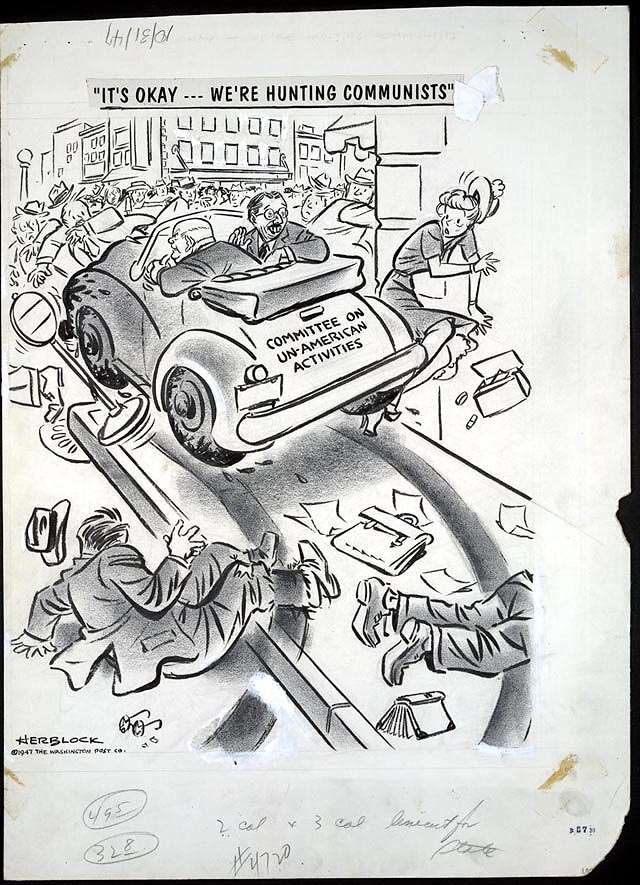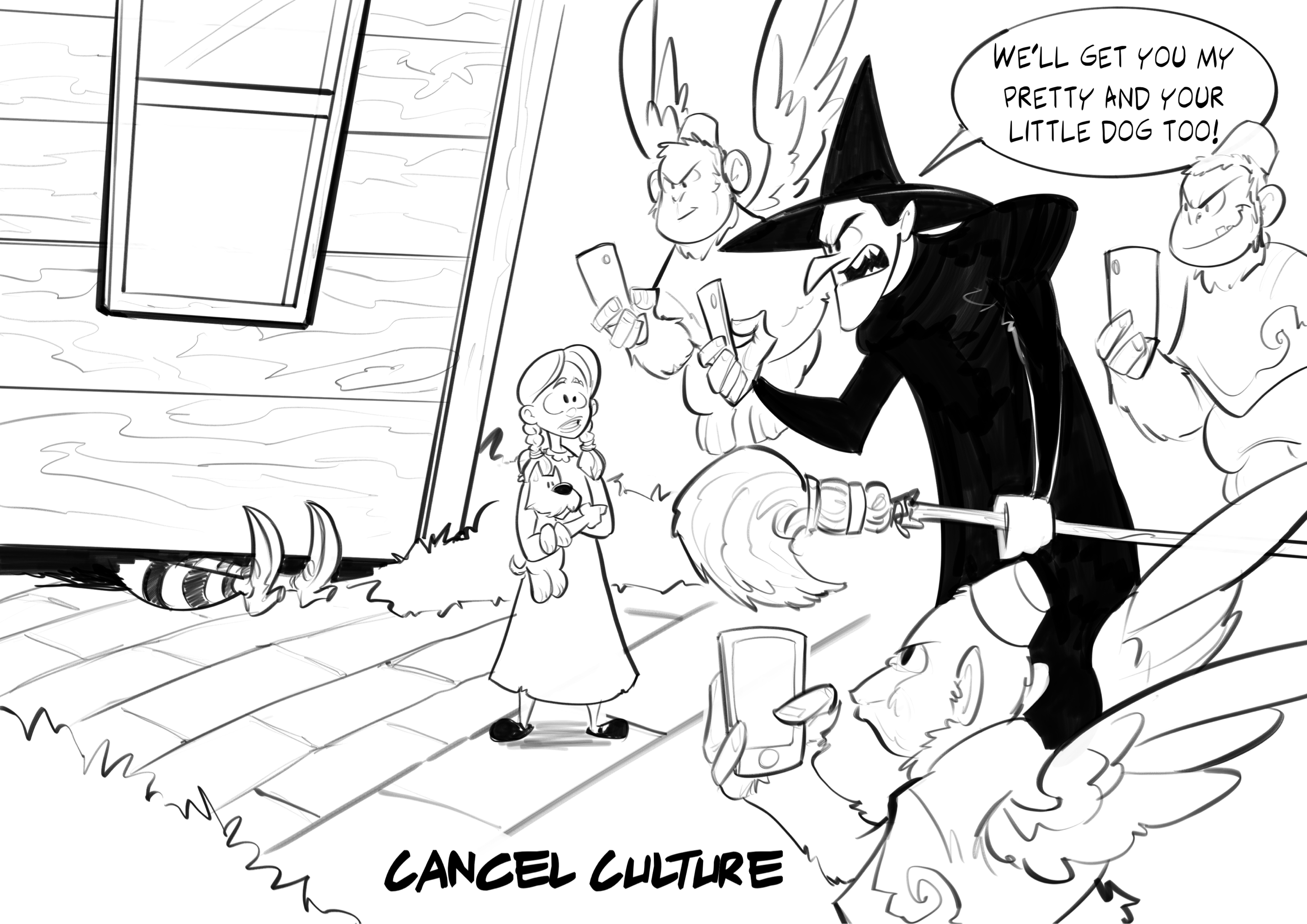Summary
This lesson will introduce students to the Second Red Scare (also known as the era of McCarthyism), the House of Un-American Activities Committee (HUAC), and the public fear of communism that ran rampant in the 1940s and 1950s. Students will analyze a political cartoon that addresses the public fear of communism; reflect upon and summarize what they have learned in a video about McCarthyism; analyze excerpts of testimony delivered by four entertainers summoned by HUAC: Lucille Ball, Edward Dmytryk, Paul Robeson, and Pete Seeger; and make connections between the Hollywood blacklist and the cultural climate today.
Essential Question(s)
What impact did the Second Red Scare have on the United States?
Snapshot
Engage
Students will analyze a political cartoon addressing the public fear of communism using the T.A.C.O.S. strategy.
Explore
Students will view a video about McCarthyism, and they will use either the POMS or S-I-T strategies to reflect upon and summarize what they have learned.
Explain
Students will use the SOAPSTone strategy to interpret excerpts of testimony delivered by four entertainers summoned by HUAC: Lucille Ball, Edward Dmytryk, Paul Robeson, and Pete Seeger.
Extend
Students will use the True for Who? strategy to compare and contrast the perspectives of individuals whose words are included in the transcripts. Students will have the option of staging mock trials that will bring to life the testimony they have read.
Evaluate
Students will write an Exit Ticket paragraph in which they will analyze another political cartoon in order to draw connections between McCarthyism and current events.
Materials
Lesson Slides - (attached)
T.A.C.O.S. handout - (attached; optional; one per student)
Surprising, Interesting, Troubling handout - (attached; optional; one per student)
SOAPSTone handout - (attached; one per student)
SOAPSTone Teacher's Guide - (attached)
True for Who? handout - (attached; one per group)
True for Who? Teacher's Guide - (attached)
Lucille Ball HUAC Testimony Transcript - (attached; one per student)
Edward Dmytryk HUAC Testimony Transcript - (attached; one per student)
Paul Robeson HUAC Testimony Transcript - (attached; one per student)
Pete Seeger HUAC Testimony Transcript - (attached; one per student)
Pencil or pen and notepaper
Student computers or tablets for internet access
Engage
15 Minute(s)
Introduce the lesson using the attached Lesson Slides. Display slide 2 to share the essential question and slide 3 to go over the lesson's learning objectives. Review them with students to the extent you feel necessary. Clarify for students that they will be hearing the terms "Second Red Scare" and "era of McCarthyism" used interchangeably, but they both refer to the same period in history.
Move to slide 4 and share the instructional strategy T.A.C.O.S. with students.
Display slide 5 and pass out the optional attached T.A.C.O.S. handout to students. Provide students with time to look at the political cartoon that was published on October 31, 1947, after a week of testimony by Hollywood screenwriters including Ring Lardner, Jr., Lester Cole, Bertolt Brecht, and John Howard Lawson.

In this cartoon, artist Herbert Block depicts an automobile named "Committee on Un-American Activities" being driven recklessly by HUAC Committee Chairman, J. Parnell Thomas, as he runs over pedestrians on the sidewalk. The passenger, HUAC Chief Investigator, Robert E. Stripling, is reassuring the injured that "It's ok [because] we're hunting communists."
Allow for some time for class discussion of this political cartoon before moving on.
Explore
15 Minute(s)
Display slide 6 and share the 5-minute video, What is McCarthyism? And how did it happen?, with students.
Optional slides 7 and 8 have been included for you to use should you want to have students share the Point of Most Significance or something Surprising, Interesting, and Troubling in the video once it is over. Additionally, there is an optional Surprising-Interesting-Troubling handout to pass out.
Move to slides 9-14 and take about five minutes to provide students with some background information on HUAC, Lucille Ball, Edward Dmytryk, Paul Robeson, Pete Seeger, and the Hollywood Ten.
Explain
45 Minute(s)
Display slide 15. Pass out the attached SOAPSTone handout and share the instructional strategy SOAPSTone with students.
Move to slide 16. You have the option of either printing the attached HUAC Testimony Transcripts of Lucille Ball, Edward Dmytryk, Paul Robeson, and Pete Seeger and distributing them to students or having students access the linked Wakelet to read them.
Instruct students to take roughly half an hour to read through the transcripts. As they read, have them fill in their SOAPSTone handout with notes from the transcripts. Most of the information for their handout is pretty straightforward but understanding and pinpointing the tone of the interviews is what you want the students to focus on. Once the students have had an opportunity to read the transcripts and to work through their SOAPSTone handout, assign them into small groups and allow them about ten minutes to collaborate and share their responses. This is a good time for students to clear up any misconceptions they may have.
In order to get a sense of the types of responses that students should be providing on their handouts, feel free to consult the attached SOAPSTone Teacher's Guide.
Extend
45 Minute(s)
Display slide 17 and share the instructional strategy True for Who? with the students. Assign students to groups of 3 or 4. Distribute a copy of the True for Who? handout to each group. Instruct students to read and follow the directions on the top of the page. Let the groups know that they will have about 15 minutes to discuss and fill out their handouts.
To get a better idea of the types of responses that would be acceptable for this activity, feel free to consult the attached True for Who? Teacher's Guide.
After the students have completed the activity, take about 5 minutes to use slides 18-29 to facilitate a whole group discussion.
After the students complete the activity, have them choose one of the statements and, using text evidence, briefly write about why they think that statement is fitting for their chosen witness.
Evaluate
10 Minute(s)
Display slide 30 and give students a moment to study the following political cartoon:

For this Exit Ticket, do not explain the cartoon to students, but ask them instead to take out a sheet of paper and take five minutes to write a paragraph or two in response to the following prompt:
What is the cartoonist trying to say about our current society?
Compare and contrast the behavior hinted at in this cartoon with the effects of the public's fear of communism during the Second Red Scare.
You can use slides 31-34 as an epilogue to the lesson. Each contains information about the outcome of the hearings and the impact that they had on each entertainer's life.
Resources
AustinMini 1275. (2018, February 9). Lucille Ball. Flickr. [Photograph]. https://www.flickr.com/photos/14639118@N03/26302339438
Block, H. (1947, October 31). It's okay.…[W]e're hunting communists. Library of Congress. Library of Congress Prints and Photographs Division. Retrieved April 13, 2022, from https://www.loc.gov/pictures/item/00652190/
K20 Center. (2020, September 16). Bell ringers and exit tickets. Strategies. https://learn.k20center.ou.edu/strategy/125
K20 Center. (n.d.). Elbow partners. Strategies. https://learn.k20center.ou.edu/strategy/116.
K20 Center. (2020, September 16). POMS: Point of most significance. Strategies. https://learn.k20center.ou.edu/strategy/101
K20 Center. (2021, February 12). S-I-T (surprising, interesting, troubling). Strategies. https://learn.k20center.ou.edu/strategy/926
K20 Center. (2021, May 28). SOAPSTone. Strategies. https://learn.k20center.ou.edu/strategy/889
K20 Center. (2021, April 15). T.A.C.O.S. Strategies. https://learn.k20center.ou.edu/strategy/1196
K20 Center. (2021, April 15). True for who? Strategies. https://learn.k20center.ou.edu/strategy/1586
K20 Center. (2022, March 9). Wakelet. Tech tools. https://learn.k20center.ou.edu/tech-tool/2180
Los Angeles Times. (1947, December 11). Charged with contempt of Congress, nine Hollywood men give themselves up to U.S. Marshal today. Wikimedia Commons. [Photograph]. https://commons.wikimedia.org/wiki/File:Nine_of_the_Hollywood_10_charged_with_contempt_of_Congress_1947.jpg.
Schrecker, E. (2017, March 14). What is McCarthyism? And how did it happen? Ted-ED. [YouTube video.] Retrieved April 13, 2022, from https://ed.ted.com/lessons/what-is-mccarthyism-and-how-did-it-happen-ellen-schrecker
Schwarz, J. (1986, February 20). Pete Seeger concert photo b&w. Wikimedia Commons. [Photograph]. https://commons.wikimedia.org/wiki/File:Pete_Seeger_1986.jpg.
Washington Area Spark. (1946, September 23). Paul Robeson sings out against lynching: 1946. Flickr. [Photograph]. https://www.flickr.com/photos/washington_area_spark/15201050315.
Webster, S. (2022). Cancel culture. K20 Center. [Cartoon].
Wikipedia. (2018, January 9). U.S. filmmaker, Edward Dmytryk. [Photograph]. https://en.wikipedia.org/wiki/File:Edward_Dmytryk.jpg.


